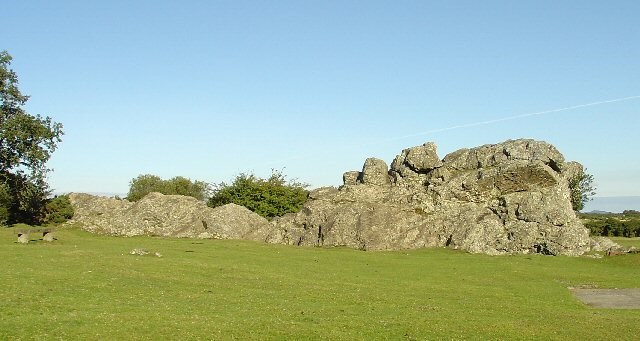*********************************************
Our first EarthCache for Roborough Rock

*********************************************
My research has brought me to the conclusion that Roborough Rock is Magnesian Limestone, which is an example of one of the three main types of rock detailed below. It is known locally as "The Rock". I have found four sources which suggest magnesian limestone but there are a few other sources suggesting The Rock is in fact Granite. The limestone contains high concentrations of the magnesium rich mineral – dolomite, and it’s the abundance of this dolomite that accounts for characteristic Magnesian Limestone flora and fauna. Limestone its self is calcium carbonate (CaCO3) while Magnesian limestone is calcium magnesium carbonate (CaMg(CO3)2). Roborough stone has been sourced right across Roborough Common and used in several local churches such as Tamerton Foliot, Plympton and Shaugh Prior; it has a warm colour, no sparkle and becomes pitted over time. When looking at Roborough Rock you can see that there are two high ends and a lower section in the middle. This middle section was removed way back in the 1830's and used for road maintenance.

There are three main rock types. These are as follows.
Igneous Rock
Igneous rock (derived from the Latin word ignis meaning fire). Igneous rock is formed through the cooling and solidification of magma or lava. Igneous rock may form with or without crystallisation, either below the surface as intrusive rocks or on the surface as extrusive rocks. This magma can be derived from partial melts of existing rocks in either a planet's mantle or crust. Typically, the melting is caused by one or more of three processes: an increase in temperature, a decrease in pressure, or a change in composition. Examples of igneous rocks include Granite and Basalt.
Metamorphic rock
Metamorphic rocks arise from the transformation of existing rock types, in a process called metamorphism, which means "change in form". The original rock is subjected to heat (temperatures greater than 150 to 200 °C) and pressure (1500 bar), causing profound physical and/or chemical change. The original rock may be a sedimentary rock, an igneous rock or another older metamorphic rock. Metamorphic rocks make up a large part of the Earth’s crust and are classified by texture and by chemical and mineral assemblage. They may be formed simply by being deep beneath the Earth's surface, subjected to high temperatures and the great pressure of the rock layers above it. They can form from tectonic processes such as continental collisions, which cause horizontal pressure, friction and distortion. They are also formed when rock is heated up by the intrusion of hot molten rock called magma from the Earth's interior. The study of metamorphic rocks (now exposed at the Earth's surface following erosion and uplift) provides information about the temperatures and pressures that occur at great depths within the Earth's crust. Some examples of metamorphic rocks are slate, marble, schist and quartzite.
Sedimentary rock
Sedimentary rocks are types of rock that are formed by the deposition and subsequent cementation of that material at the Earth’s surface and within bodies of water. Sedimentation is the collective name for processes that cause mineral and/or organic particles to settle in place. The particles that form a sedimentary rock by accumulating are called sediment. Before being deposited, the sediment was formed by weathering and erosion from the source area, and then transported to the place of deposition by water, wind, ice, mass movement or glaciers. Sedimentation may also occur as minerals precipitate from water solution or shells of aquatic creatures settle out of suspension. Examples of sedimentary rocks include sandstone, limestone, chalk and clay.
In Order to claim this find we require you to answer a few simple questions based on Roborough Rock and the area. Please send your answers to our email address via our profile or through the message centre on geocaching.com.
1. As you stand facing towards the eastern face (with your back to the road and parking on your right) and you will notice a few rocks coming away from the main tor at ground level. Can you please describe the colours in the furthest rock away?
2. Based on the three main types above. Which type of rock do you think Roborough Rock an example of?
3. Look up about 7 Ft from ground level and there is a plant that is well established. What is this plant?
4. There is a monument nearby made out of the Roborough Stone. What are the two letters on the monument in between two dates? The dates are 1837 – 1897 (see additional waypoint)
This is not essential for logging requirements but it would be nice if you logged a photo of your visit
Please go ahead and log your find after sending us your answers. If there are any problems we will contact you. Thanks to Dartmoor National Park Authority for their kind permission to place this Earth Cache.
